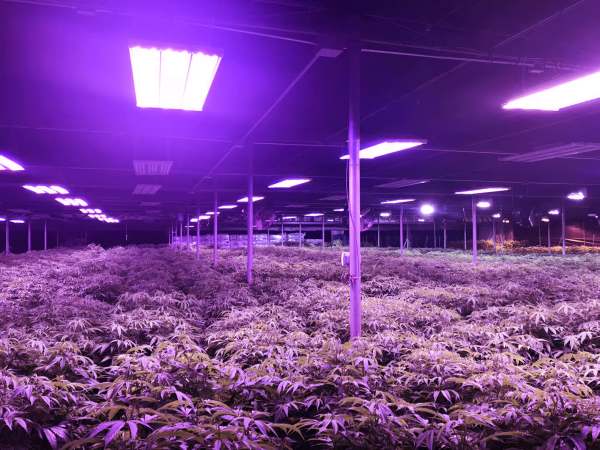What is the function of LED plant light? What are the characteristics?
Light has two effects on plant growth, one is indirect, and the other is direct. LED plant light manufacturers are more environmentally friendly and energy-saving. LED plant lights provide photosynthesis to plants, promote plant growth, shorten the time it takes for plants to bloom and bear fruit, and increase production! In modernization, it is an indispensable product of crops.
The law of plant growth must require sunlight, and the LED plant growth lamp is a kind of lamp that uses the principle of sunlight to replace sunlight to provide the environment for plant growth and development. Therefore, it can better promote the growth of plants at night or under dark conditions.
What is the function of LED plant growth light? What are the characteristics?

led plant linght
1. According to the degree of plant light, control the irradiation time of the LED plant light.
It is generally believed that almost all living organisms need to rest. Therefore, it is not feasible to use LED plant lights to supplement the light of plants 24 hours a day. After a lot of research and experimentation, it has been proved that it is appropriate to control the plants to add light for 16 hours and 18 hours, and leave enough time for the plants to rest for 4-6 hours.
For bright plants, when the sun can meet their growth needs under sunny conditions, the sun can meet their growth needs. It takes about 11 hours to supplement the plants with a plant growth lamp.
Similarly, if the requirements for light are not very high, if there is sunlight, it can already meet its growth needs. The time for supplementing light with LED plant lights only needs to be set according to the local sunrise and sunset time, and the supplementary light time can try to avoid effective rest time for plants.
Plant growth lamp supplement light time 1. As supplementary light, it can enhance the light at any time of the day, which can extend the effective lighting time. 2. Whether it is at dusk or at night, it can effectively extend and scientifically control the light required by plants. 3. In a greenhouse or plant laboratory, it can completely replace natural light and promote plant growth. 4. Thoroughly solve the situation that the seedlings need to be eaten according to the day, and arrange the time according to the delivery date of the seedlings. The choice of plant growth lamp Scientific choice of light source can better grasp the speed and quality of plant growth. When using artificial light sources, we must choose the natural light closest to satisfying the conditions of plant photosynthesis. Measure the photosynthetic luminous flux density produced by the light source to the plant, grasp the photosynthesis rate of the plant and the efficiency of the light source, the light quantity of photosynthetically effective photons in the chloroplast initiates the photosynthesis of the plant: including the light response and the subsequent dark response.
2. Set the irradiation time of LED plant lights according to the planting environment.
The plant growing environment mentioned here includes the regional differences between north and south, spring, summer, autumn and winter, as well as the difference in the intensity of indoor and outdoor sunlight.
According to the law of light, the stronger the equator, the stronger in summer and winter. According to local conditions, the irradiation time of LED plant growth lights can be set according to local conditions.
The acceptable light for indoor and outdoor planting is very different. It takes 16 hours and 18 hours to charge with LED plant lights. It can adjust the light intensity of LED plant lights according to the degree of indoor natural light reception, while outdoor plant growth lights can refer to the first point to supplement light. 1. Convert electrical energy into radiant energy with high efficiency. 2. Achieve high radiation intensity within the effective range of photosynthesis, especially low infrared radiation (heat radiation) 3. The emission spectrum of the bulb meets the physiological requirements of plants, especially in the effective spectrum of photosynthesis.
The LED plant growth lamp used in the field of plant cultivation also embodies the following characteristics: the wavelength type is abundant, which coincides with the spectrum scale of plant photosynthesis and light morphology; the half width of the spectrum wave width is narrow, which can be combined to obtain pure monochromatic light and composite spectrum according to the needs. LED plant lights can focus on specific wavelengths of light to irradiate crops in a balanced manner; plant lights can not only adjust the flowering and firming of crops, but also control plant height and plant nutrients; the system generates less heat and occupies a small space, and can be used for multi-layered cultivation planes The combined system realizes low heat load and miniaturization of production space; in addition, the strong durability of LED plant lights also reduces operating costs.
LED plant light manufacturers do not use fertilizers at all for organic planting, but organic fertilizers can be used: farmhouse fertilizers, mineral fertilizers, biological bacteria fertilizers, etc. after high-temperature fermentation and harmless treatment. Due to the limitation of this kind of fertilization, the growth cycle of plants is bound to be affected, and the current large demand in the market appears to be in short supply. Therefore, shortening the production cycle is one of the methods.
This kind of LED plant lamp has strong roots, promotes, regulates the flowering period and flower color, promotes fruit maturity, coloring, and enhances the taste and quality of the fruit! Because of these obvious characteristics, LED plant lights are very suitable for plant cultivation in a controllable equipment environment, such as plant tissue culture, equipment gardening and factory seedlings, and aerospace ecological life support systems. The effects of different spectral components of LED plant lights on plants.






